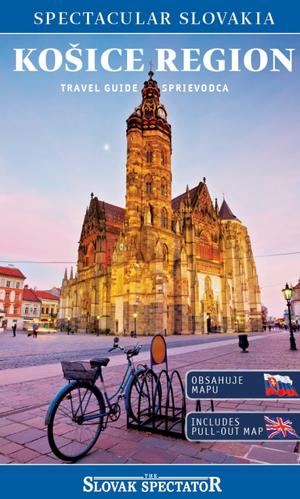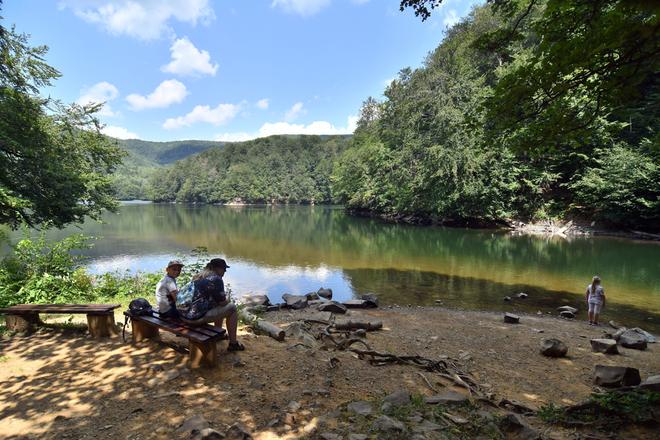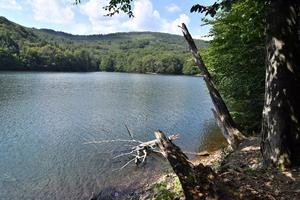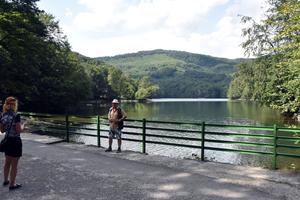The primeval forest in the vicinity of Morské Oko, the third largest natural lake in Slovakia, is one of the most easily accessible old forests in Slovakia.
The Vihorlatský Les forest nature forest on the border of the Humenné, Snina, Michalovce and Sobrance districts, one of the five Slovak components included in the UNESCO World Natural Heritage List as Old Beech Forests and Beech Forests of the Carpathians and other regions of Europe, is an extensive complex of beech trees stretching along the main crest of the Vihorlatské vrchy up to the Nežabec massif.
 Let this guide be your key to the most ravishingly beautiful secrets of the Košice Region (www.spectacularslovakia.sk) (source: Spectacular Slovakia)
Let this guide be your key to the most ravishingly beautiful secrets of the Košice Region (www.spectacularslovakia.sk) (source: Spectacular Slovakia)
A mountain of contrasts
As stated by the director of the Vihorlat Protected Landscape Area Administration, Zuzana Argalášová, the area is rich in natural peculiarities.
"This mountain range is a range of contrasts, interesting reserves with rare flora and fauna, lakes, rock formations, bogs and many other natural features," she said, as quoted by the TASR newswire.
According to Argalášová, the reserve's beech forests are characterised by a low representation of spruce and fir. These trees naturally occur only in the Jedlinka area.
Beech trees shelter rare inhabitants
In the territory, there are mainly homogeneous beech trees of a forest-like nature with a mixture of mountain maple, ash and mountain elm.
"During the mapping of primeval forests, the thickest circumference of the trunk was measured at 357 centimetres for the beech in the vicinity of Morské oko, and 293 centimetres for the mountain maple," she added, as quoted by TASR.
At the same time, the beeches provide a home for animals of European importance, the Alpine longhorn beetle, the gray wolf, the brown bear, the lynx, the fire salamander and the Carpathian blue slug.
Thousands of people will walk the educational trails
The total area of this territory of worldwide importance is 2,160.544 hectares, part of it lying in the military district of Valaškovce, the reason why it is not accessible to the public.
"The rest of the territory is highly accessible through a network of educational and tourist trails, well connected to one another," explained Argalášová.
The most visited educational trail is Morské oko – Sninský kamen – Sninské rybníky.
Last year, Morské oko was visited by almost 65,000 people.
"On the trail, you can see beautiful examples of beech trees with a forest-like character, as well as examples of how natural communities are allowed to develop in this area without interference," the conservationist pointed out, adding that the easy accessibility of the area is made possible by car access to the parking lot near Morské oko.
According to Argalášová, the educational trail through the Vihorlat beeches starting in Poruba pod Vihorlatom in the Michalovce district and ending at the Tri table saddle is also interesting.
"Here it is possible to admire how an endless natural cycle takes place without human intervention, where old trees give way to new ones and they immediately grow in a suitable place," she concluded.
World cultural and natural heritage
On the occasion of this year's 50th anniversary of the Convention on the Protection of World Cultural and Natural Heritage, along with the 30th anniversary of the inclusion of the first Slovak monuments in the World Heritage List, the films Carpathian Beech Forests in Slovakia and Carpathians - Hidden Wealth, are shown every Wednesday and Friday at Morské oko.
The Slovak part of the old beech forests and primeval forests of the Carpathians is located in Poloniny National Park and the Vihorlat protected area.
In addition to Vihorlat, it consists of Havešová, Stužica - Bukovské vrchy, Udava and Rožok.

Spectacular Slovakia travel guides
A helping hand in the heart of Europe thanks to the Slovakia travel guide with more than 1,000 photos and hundred of tourist spots.
Detailed travel guide to the Tatras introduces you to the whole region around the Tatra mountains, including attractions on the Polish side.
Lost in Bratislava? Impossible with our City Guide!
See some selected travel articles, podcasts, traveller's needs as well as other guides dedicated to Nitra, Trenčín Region, Trnava Region and Žilina Region.



 Morské oko in the Vihorlat Mountains, eastern Slovakia. (source: TASR)
Morské oko in the Vihorlat Mountains, eastern Slovakia. (source: TASR)


